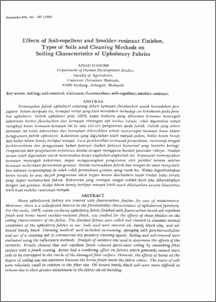Citation
Hashim, Aziah
(1986)
Effects of Soil-repellent and Smolder-resistant Finishes,
Types of Soils and Cleaning Methods on
Soiling Characteristics of Upholstery Fabrics.
Pertanika, 9 (3).
pp. 401-407.
Abstract
Many upholstered fabrics are treated with fluorocarbon finishes for ease of maintenance.
Moreover, there is a widespread interest in the flammability characteristics of upholstered f1fmiture.
For this study, 100% cotton corduroy upholstery fabric finished with fluorocarbon based soil-repellent
finish and borax based smolder-resistant finish, was studied for the effects of these finishes on the
soiling characteristics of the fabric. The finished fabrics were soiled and cleaned to simulate normal
conditions of the upholstery fabrics in use. Soils used were mineral oil, bandy black clay, and oil bound
bandy black. Cleaning methods used included vacuuming, sponging with perchloroethylene
and use of a cleaning aid (a commercial dry powdery cleaning agent). Soiling and soil-removal were
evaluated using the reflectance methods. Analysis of variance was used to determine the effects of the
variables. Results showed that soil repellent finish reduced particulate soiling by smoothing fiber
surface with a finish coating. Borax had a tendering effect on fabrics which generally caused more
soils to be entrapped in the cracks of the damaged fiber surface. However, the effects of borax on the
degree of soiling was not extensive because the borax finish made the fabric whiter. The traces of soils
were relatively small in relation to the fiber size. Oil-bound bandy black soils were more difficult to
remove due to their greater attachment to the fabric via oil-bonding.
Download File
![[img]](http://psasir.upm.edu.my/style/images/fileicons/application_pdf.png)  Preview |
|
PDF
Effects_of_Soil-repellent_and_Smolder-resistant_Finishes,.pdf
Download (4MB)
|
|
Additional Metadata
Actions (login required)
 |
View Item |

